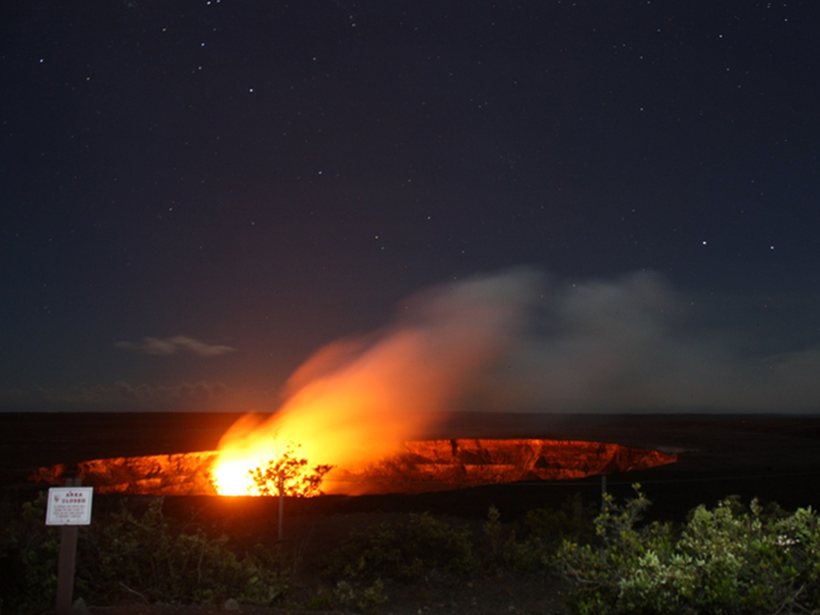The study of rock physics continues to grow rapidly in importance as geophysicists strive to provide more complete interpretations of geophysical observations using increasingly advanced data acquisition methods. A meeting last summer provided a timely venue for a review of the state of the science from an assortment of the leading practitioners.
This series of meetings brings together scientists who might not normally interact but who share many common interests and research goals.
The American Geophysical Union and the Society of Exploration Geophysicists (SEG) have in the past few years promoted a series of jointly organized meetings to bring together scientists who might not normally interact but who share many common interests and research goals. The latest of these collaborations was a rock physics workshop held in Hilo, Hawaii, last July.
The conference drew 56 scientists from Europe, Asia, Australia and New Zealand, and North America. Attendees covered a wide range of specialties spanning those who focus on metamorphic, magma system, and sedimentary rocks, as well as those who use experimental, theoretical, and modeling approaches.
The meeting was organized around six themes that centered on tectonics, rock physics theory and modeling, experimental developments, fractures and transport properties, evolving rock systems, and rock microstructure. Each session began with presentations from invited speakers providing overviews of their recent research. These were followed by “speed geeking”–style presentations: Each poster presenter gave a short 4-minute synopsis talk to prepare attendees for the open poster session.
Discussions revolved around advancements in four realms: fundamental understanding of permeability through matrix and fracture networks, the modeling of geophysical responses at differing scales, the deformation of rocks in the brittle and ductile regimes, and the study of elastic dispersion (the speeds at which various frequencies of seismic waves travel through rocks saturated with fluids) from seismic to ultrasonic scales. This latter topic has experienced rapid growth in recent years.
Participants learned about a variety of new experimental and numerical tools that allow researchers to probe material structure and physical properties, illustrating some of the directions that rock physicists will take in the coming decade. Examples of rock physics applications for the interpretation of field geophysical data showed the necessity of having a better understanding of rock physics in geophysical monitoring for hydrocarbon and carbon sequestration.
The venue provided an exceptional opportunity to see rock physics in action.
The venue provided an exceptional opportunity to see rock physics in action with a field trip to the Hawai‘i Volcanoes National Park. The field trip included a visit to the U.S. Geological Survey’s (USGS) Hawaiian Volcano Observatory, hikes through lava tubes, and an after-sunset viewing of the glow from the active lava lake in Kīlauea Iki, a pit crater near the main Kīlauea summit caldera.
We owe special thanks to the SEG expediter Jill Abbott, the workshop technical committee, and scientists at the USGS Hawaiian Volcano Observatory. We also thank the SEG Foundation for providing six student scholarships to assist with travel expenses.
A special collection of the Journal of Geophysical Research: Solid Earth is now being compiled to capture an up-to-date snapshot of the field of rock physics. This collection will include contributions from the workshop presenters, but we also enthusiastically encourage contributions from researchers who were not able to attend the conference. The submission deadline is 31 March 2017, and a description of the collection and direct submission link are available on the journal’s “Rock Physics of the Upper Crust” Web page.
—Ludmila Adam, School of Environment, The University of Auckland, New Zealand; and Douglas R. Schmitt (email: [email protected]), Institute for Geophysical Research, Department of Physics, University of Alberta, Edmonton, Alberta, Canada
Correction, 27 January 2017: The title of this meeting has been corrected to agree with the way the meeting is listed elsewhere.
Citation:
Adam, L.,Schmitt, D. R. (2017), Developments in the study of rock physics, Eos, 98, https://doi.org/10.1029/2017EO065399. Published on 09 January 2017.
Text © 2017. The authors. CC BY-NC-ND 3.0
Except where otherwise noted, images are subject to copyright. Any reuse without express permission from the copyright owner is prohibited.

